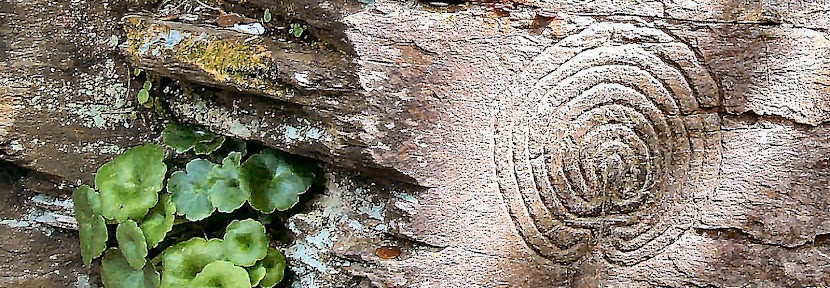The Holy Wells of Old Bodmin Town
by Alex Langstone
The highland granitic expanse of Bodmin Moor covers much of North East Cornwall, covered with hundreds of ancient archaeological sites; standing stones, cairns, stone circles and hut circles, the moor attracts visitors who want to explore the ancient landscape, climb the highest hills in the Duchy and enjoy the vast wide-open rugged vistas across moor, heath and valley.
Not so well known is the old town, from whence the moor takes its name. Bodmin has a long and distinguished history. St Guron founded a monastery here in the 6th century and shortly afterwards St Petroc arrived and took over the holy spot, where the church now stands. Today the town still boasts the largest parish church in Cornwall. The church is dedicated to St Petroc and is largely 15th century. Interestingly the church still contains the ivory casket of St Petroc, which held the relics of the founding saint at least since the 12th century. The relics were stolen in 1177 and taken to St Meen's Abbey in Brittany. Henry II intervened and the relics were returned in the ivory casket that can still be seen today! This historic event is commemorated every year at the Bodmin Riding ceremony held at the beginning of each July.
The town's name comes from the Cornish "bod" (dwelling) and "monegh" (monks). A direct reference to the importance of the settlement in its early days of ecclesiastical power. It is very likely because of this religious status the early town enjoyed that the many ancient holy wells, most which pre-date Christianity, have survived around the quaint and historic town.
The town's priory park contains a few remains of the old Bodmin Priory including the Holy Well of St Petroc, which is the first of the town's Holy Wells we shall visit.
This beautiful old well is situated at the edge of the town's Priory Park, close to but hidden from the town's football club. The well is sited in a hollow, beneath an old oak tree. The water level is normally very high, due to some previous flood alleviation works, covering most of the seventeenth century granite arched well basin. A statue of the Virgin was found here during restoration work, and was restored by the monks at Buckfast Abbey, before being presented to Bodmin's Catholic community. It now resides in the town's St Mary's church. This Holy Well would have originally served the once great Bodmin Priory, and the spot still exudes a sense of mystery and wonder, and is a peaceful spot for reflection.
Scarlett's well, is another of Bodmin's peaceful and secluded holy wells. A mineral rich healing well situated by the beginning of the Camel trail on the edge of town. The site is set back into an Ivy clad bank, where a spring gushes forth from the hillside and flows into a granite trough which holds the water briefly before it continues its flow towards the bubbling stream which meanders along the valley floor towards the larger River Camel and beyond to the Atlantic Ocean. This site is very beautiful and peaceful. The well was once part of the Priory of Bodiniel and has many stories of healing and miracles associated with it. Joan Wytte of Bodmin was a witch, known in her day as the fighting fairy woman of Bodmin. She is reputed to have used the well for scrying and healing. Another Bodmin wise woman, known as Old Nell also used the wells mystical waters to aid her cures, and her old water pitcher can still be viewed in The Museum of Witchcraft and Magic in Boscastle.
There are several lost holy wells around the town. There was the Bodmin Holy Well, which was situated about a mile away from Scarlett's well in Fairwash Combe. Thomas Quiller-Couch has this to say about this ancient sacred place:
"A mile or so above Scarlett's well in the Fairwash Combe, is the clear and perennial fountain, still giving its name to the field in which it is situated. The well is not now, if it ever was, enclosed by any masonry; but the limpid stream runs into a granite trough, the overflow irrigating the grass below. It had great repute among the dead and gone of Bodmin; still the aged retain some remembrance of it, and tell me how in their youth they used to frequent the Holy Well to divine their future by rushes from the marsh below tied crosswise (with a now forgotten verse) put to float on the water. On a recent visit I searched for votive coin or pin, but found none. Hydromancy is dead in this generation."
from Ancient and Holy Wells of Cornwall by Thomas Qullier-Couch 1826-1884.
References.
Ancient and Holy Wells of Cornwall by T. Quiller-Couch. C. J. Clark, London. 1894 Secret Shrines by Paul Broadhurst. Pendragon Press. Launceston. 1997
Fentynyow Kernow by Cheryl Straffon. Meyn Mamvro Publications. St Just. 2005.









Research is currently ongoing regarding these lost holy wells, and I shall hopefully be able to report more fully on them soon.
ReplyDeleteHi I have got a old magazine all about bodmins holy wells, i bought on ebay this may help
you.
Regards
Mark carbooter2010@hotmail.co.uk